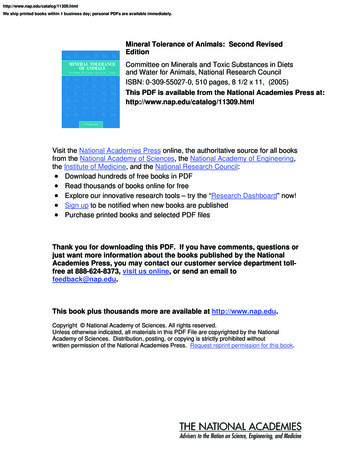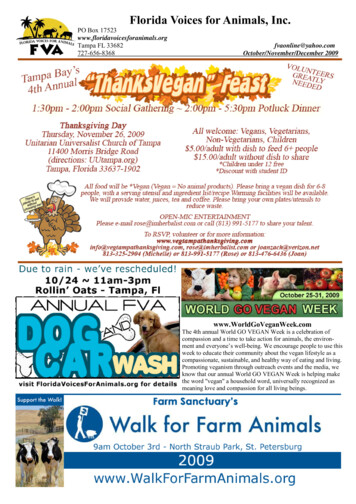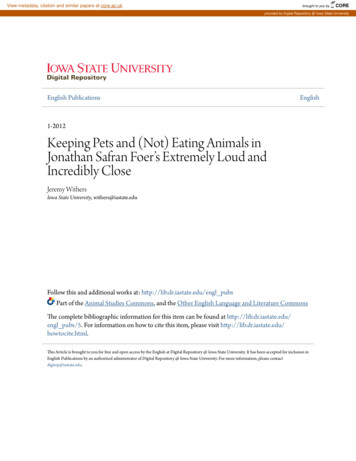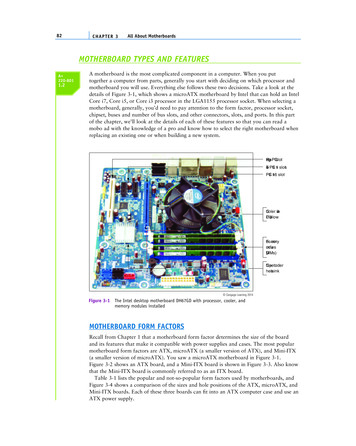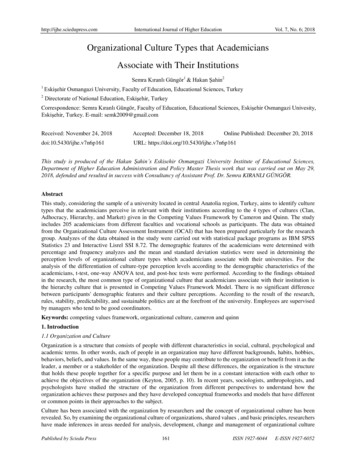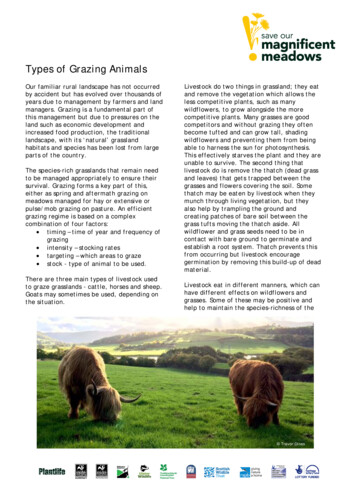
Transcription
Types of Grazing AnimalsOur familiar rural landscape has not occurredby accident but has evolved over thousands ofyears due to management by farmers and landmanagers. Grazing is a fundamental part ofthis management but due to pressures on theland such as economic development andincreased food production, the traditionallandscape, with its ‘natural’ grasslandhabitats and species has been lost from largeparts of the country.The species-rich grasslands that remain needto be managed appropriately to ensure theirsurvival. Grazing forms a key part of this,either as spring and aftermath grazing onmeadows managed for hay or extensive orpulse/mob grazing on pasture. An efficientgrazing regime is based on a complexcombination of four factors: timing – time of year and frequency ofgrazing intensity – stocking rates targeting – which areas to graze stock - type of animal to be used.There are three main types of livestock usedto graze grasslands - cattle, horses and sheep.Goats may sometimes be used, depending onthe situation.Livestock do two things in grassland; they eatand remove the vegetation which allows theless competitive plants, such as manywildflowers, to grow alongside the morecompetitive plants. Many grasses are goodcompetitors and without grazing they oftenbecome tufted and can grow tall, shadingwildflowers and preventing them from beingable to harness the sun for photosynthesis.This effectively starves the plant and they areunable to survive. The second thing thatlivestock do is remove the thatch (dead grassand leaves) that gets trapped between thegrasses and flowers covering the soil. Somethatch may be eaten by livestock when theymunch through living vegetation, but theyalso help by trampling the ground andcreating patches of bare soil between thegrass tufts moving the thatch aside. Allwildflower and grass seeds need to be incontact with bare ground to germinate andestablish a root system. Thatch prevents thisfrom occurring but livestock encouragegermination by removing this build-up of deadmaterial.Livestock eat in different manners, which canhave different effects on wildflowers andgrasses. Some of these may be positive andhelp to maintain the species-richness of the Trevor Dines
grassland, whilst others may be negative.Occasionally, it may be recommended tograze a grassland harder to reduce scrubencroachment, create small areas of bareground to help seeds germinate and take thegrassland back to an earlier stage ofecological succession 1.In an ideal world, a combination of mixedstocking will produce the best managementoutcome. All grazing animals need: water – via a trough, man-madechannel or naturally occurring. shelter – against the worst weather orshade in summer. Even if there are nothousing facilities on each site, thereshould be trees, bushes or rock1Ecological succession - the progressivereplacement of one community by another until aclimax community is established. outcrops that livestock can retreat tooin severe conditions.fencing – appropriate fencing that iswell maintained.attention – the livestock should bechecked at suitable intervals, whichmay be daily.care – on site and off site visits by avet may be required.It can be difficult to move livestock betweenfarm holdings, particularly in areas with highTB. Movement licenses are required for sometypes of stock and standstill periods mayapply. This can cause difficulties if there are‘flying’ herds of animals used to grazespecies-rich grasslands. All grasslands are amanaged environment and if grazing cannotbe undertaken, some other form ofmanagement may need to be done toreplicate grazing, such as mowing andharrowing.
CattleCattle prefer to eat longer grasses and usetheir tongue to pull and tear the vegetation;grazing to a minimum height of 5-6 cm. Theyare generally better than sheep at creatingand maintaining structurally diversegrassland: their large size and heavy weightbreaks up the ground; they avoid grazing around dung patswhich creates patches of longervegetation important for insectcommunities. These in turn are eatenby birds and bats; cattle are particularly good atknocking down and creating gaps intall, coarse vegetation such as brackenand scrub.Different cattle breeds have differing effectson rough grassland. Traditional breeds aremore adapt at eatingrough grassland,putting on weightand maintainingcondition forproduction,compared withcommercial breeds.Cattle need morewater than sheep,and access totroughs is requiredat all times. Thelocation of watertroughs and minerallicks can be used toinfluence wherecattle graze.Poaching or pockmarks (the excessivetrampling ofgrassland by cattlewhen wet) adverselyaffects pasture andmeadows and canlead to a hardimpenetrablesurface when dry,where plants areunable to germinate.It is a particularproblem that canoccur around water troughs and feeders andwhen cattle are over wintered outside.Cattle are particularly good at reducing someproblem grassland plant species. For example,tor-grass occurs on calcareous grassland and isnot particularly palatable for livestock.However, it is most palatable earlier in theyear when the shoots appear and cattle canbe used to spring-graze pastures where itoccurs. Spring-grazing can also be used toreduce other grasses like tufted hair-grass andpurple moor-grass.For more information on the suitability ofdifferent cattle breeds for conservationgrazing see The Breeds Profile Handbook.
Horses and poniesHorses and ponies have forward facing teethand can graze extremely close to the ground –as close as rabbits. The benefits of grazingwith horses and ponies are: they preferentially select sweetgrasses, but will also eat a variety ofsedges and rushes particularly later inthe summer; they tend not to select flowers, assheep do, and avoid buttercup,common knapweed and ragwort; they regularly graze tufted grasses,including tor-grass; these ‘fussy’ diets are ideal formaintaining the mosaic habitat neededby many insects.As with other livestock, there are behaviouraland grazing differences between horsebreeds. Native breeds such as Exmoor,Dartmoor and New Forest ponies are regardedas more suitable for rough grasslands and arehardy, being able to cope in adverse weatheras they are often reared outside without everbeing brought into a stable. In the autumn,some breeds such as New Forest ponies, willgraze large quantities of bracken once thetoxicity has reduced, making them ideal forrestoration grazing.Problems can arise in specific locations ashorses may create latrine areas, which lead toa tightly grazed vegetation and can causelocalised high nutrient levels and encouragethe spread of thistles, nettles and docks.Regular collection of dung will alleviate thisproblem and usually the more species-richareas of a site are not used as a latrine asthey are become preferred grazing locations.For more information on the suitability ofdifferent horse and pony breeds forconservation grazing see The Breeds ProfileHandbook.
SheepSheep have thin, mobile lips and move slowlyover the sward nibbling the grass. They eatselectively when circumstances allow, bitingoff single leaves or shoots down to a height of3 cm. It is notable that sheep only develop afull set of adult teeth after 3-4 years and thensteadily lose them as they age, thereforeyoung and old sheep may not graze aseffectively as middle-aged sheep. As well asgrasses and herbs, sheep will also selectivelyeat some low scrub, especially the hardybreeds such as Soay and Hebridean.The benefits of grazing with sheep are: they are light and more agile thancattle and are more suited to steeplysloping land; although on heavy, wet soils sheep cancause trampling and poaching they donot have such an impact as heaviergrazers; their dung is deposited randomly andthey will graze next to it, thereforegrazing swards to a uniformly lowheight.Sheep are less susceptible to the toxins inragwort and so can be used to spring graze itin its rosette stage to prevent flowering andsetting seed. However, they are not immuneto its toxins so require plenty of othervegetation to eat along with it. Extensivebramble can cause difficulties for sheep astheir fleece may get caught. As sheep areprone to foot rot they are not best suited topredominantly wet sites. They also requiremore secure fencing than cattle.For more information on the suitability ofdifferent sheep breeds see The Breeds ProfileHandbook.
GoatsFeral goats may be managed as a livestockherd. They are browsers, consuming woodyvegetation 50-75% of their feeding time wherethis is available, and do best on land that hasscrub and tufted grasses making themparticularly suited to restoration grazing.Usually they graze grasses down to a height ofaround 6 cm and can target grass seed headseating them before starting to eat the leaves.Like sheep, they do not develop their full setof teeth until they are five years old and canlose teeth in older age, meaning that middleaged goats are most effective.The benefits of grazing with goats are: they have a small muzzle and aflexible upper lip allowing them to behighly selective about what they eat.Goats prefer to eat the newer growthand leaves of scrub, bramble andtufted grasses rather than finergrasses; they are less prone to foot rot thansheep making them suitable for wettersites but they do need some drysheltered ground within their homerange; they are agile and can tackle steephills and rock edges, particularlysuited to cliff edges that otherlivestock would have troubleaccessing.Goats will bark strip taking in order ofpreference, holly, ash, rowan and willow,oak, hazel, alder and birch in uplandsituations. In lowland situations they tend toeat elder first, followed by ash, blackthorn,sycamore and rose. They generally do not eatfield maple or hawthorn. Bark-stripping takesplace during mid-late winter when there arefew leaves and the preceding year’s growthhas been consumed. They may also browseheather to a greater extent than sheep.Goats have been particularly used along steepcliffs, such as Burrington Combe in the MendipHills, to reduce the amount of scrub andencourage the growth of wildflowers. Theyhave also been used to reduce rush on wetgrassland, with restoration achieved after 3-4years by spring mob grazing with goats at astocking density of more than 10 animals perhectare.Goats can be difficult to manage, and areoften considered to be escape artists breakingout of enclosures. However, they can be veryeffective and different breeds can be used toaddress separate situations and issues.For more information on conservation grazingwith sheep see The Breed Profiles Handbook.
hills and rock edges, particularly suited to cliff edges that other livestock would have trouble accessing. Goats will bark strip taking in order of preference, holly, ash, rowan and willow, oak, hazel, alder and birch in upland situations. In lowland situations they tend to eat elder first, followed by ash, blackthorn, sycamore and rose.File Size: 695KB

